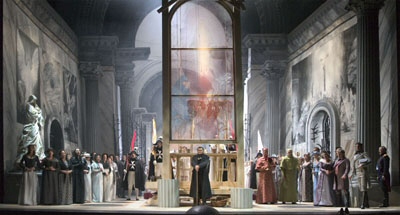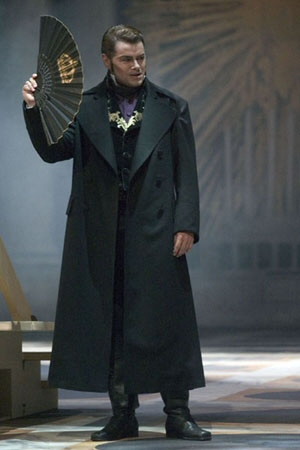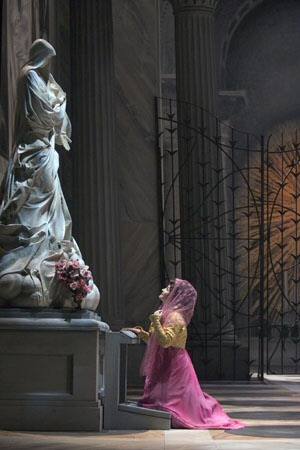Giacomo PUCCINI:
Tosca at
the Royal Opera in Stockholm on January 7, 2005 (GF)
Tosca was the first new opera of the 20th century
when it opened at the Teatro Costanzi in Rome on the 14th of January 1900. The
critics were mainly negative but the audience at large were enthusiastic
and it turned out that they were right: today, Tosca belongs somewhere in the top ten list of most played operas.
It reached Sweden in 1904, when on the 15th February
The Royal Opera in Stockholm mounted it, directed by August Lindberg.
Not until 1964 (!) was there a new production, directed by Bengt
Peterson, and it played until May 1998. So when the Royal Opera
presented a new production on September 11th 2004,
it was only the third one in 100 years. Peterson’s version, realistic,
and true to Puccini’s stage directions, became a real Warhorse.
I saw it many times from the early seventies, sometimes with international
guests, for example Ingvar Wixell, possibly the greatest Scarpia in the seventies, who
now and then returned to his old “home stage.”

This
newest version is directed by Knut Hendriksen, who has worked at the Royal Opera since 1976.
The stage sets are by Björn Brusewitz
and costumes by Ann-Mari Anttila. This is a Tosca
in a mostly traditional staging, and none the worse for that. Some
critics complained, of course, but I must say that after seeing
so many post-modernist stagings – in Stockholm and other places – it’s a relief to
see an opera that plays during the period the composer intended
and in period costumes. The most innovative feature is Scarpia’s
office in act II, when the room is lifted three or four feet during
the torture scene, so we can see the torture chamber that is under
the office. Moreover, the wallpaper in Scarpia’s room is a map of
Rome, which illustrates how Scarpia controlled the whole city. It
gives further emphasis to Tosca’s spoken lines, after killing the
chief of police: E avanti
lui tremava tutta
Roma! (And the whole of Rome trembled before him!) What has been removed, and
I don’t know why, is the religious ritual that Tosca undertakes
after the murder and which is described in detail in the libretto:
she takes two candles and puts them beside Scarpia’s head and then
puts a crucifix on his chest. I think we definitely miss something
of Tosca’s character, but maybe the director thinks that the de-Christianization
of Sweden has gone so far that nobody will understand the symbolism.
Musically
it is excellent. Romanian born conductor Christian Badea leads a taut performance with well-judged
tempos and he whips up the tension in the dramatic moments, of which
there are of course quite a lot. But he also exposes the many exquisite
touches of orchestral colouring that the score abounds with. In
between the violent proceedings there is an almost chamber music
sensitivity. He tells us that this opera is far from that “shabby
little shocker” that it has been called.

Johan
Edholm as Scarpia
The
solo singing is impressive. The very first voice we hear is Ola
Eliasson’s Angelotti, a well modulated
bass who has developed considerably since I heard him as Oroveso
in Norma a couple of years
ago. Another bass, Ketil Hugaas,
also impresses as the Sacristan. He gets a good balance between
the comic and the serious, for although this monk is a comic character
he is no mere clown, and Hugaas is genuinely
frightened when Scarpia and his henchmen appear. Johan Edholm
as Scarpia is a real find. I heard the premiere on the radio and
was impressed by his vocal resources and his intensity. Since then
his portrayal of the disgusting chief of police has deepened further
and he sings the part with an authority I haven’t heard since Wixell’s
heydays.
Mario
Cavaradossi is sung by the American tenor Theodore Green, who
has sung mainly in the US but has appeared also as Rodolfo in
Stockholm. He has a well-schooled, rather lyrical voice and my
first thought was that Cavaradossi might be a size too big for
him. His biography reveals that he has mainly been singing lighter
roles: Edgardo, Ernesto and Nemorino, The Duke of Mantua and Alfredo, Almaviva and some Mozart roles, more or less Alfredo Kraus
repertoire. And in some places, where the top notes should ring
out and ride above the orchestra, he is rather over-powered. Still
he gave a good impression, the lyrical moments, of which there
are also a lot, sounded well and he cut a nice figure on stage.
But I don’t think he should sing too many Cavaradossis before his voice has matured further.

Lena
Nordin as Tosca
His
Tosca is Lena Nordin, and here is an actress
and a singer to set beside the greats. She has been singing important
roles at the Royal Opera since the late 80s and she is so convincing,
so thrilling. Her Norma, a couple of years ago, was masterly. Here,
in a role that is forever associated with Maria Callas, she over
and over again reminds me of that great predecessor. The voice’s
timbre is similar and seeing her in profile she even looks like
Callas. And I must say that Vissi
d’arte was sung more beautifully than Callas ever managed, so
hushed, so inward that it should move anybody to tears. I wish she
would get the opportunity to record this opera, preferably on DVD
since she should be seen as well as heard.
The
opera chorus acquit themselves well in the big Te Deum scene in
act I, and the minor parts are also well taken. Anyone spending
a day or two in Stockholm should grab the opportunity to see this
performance. Hopefully it will run for several years, but probably
not for 60, maybe not even 40, as its forerunners did.
Göran
Forsling
Pictures ©Alexander
Kenney/Kungliga Operan





